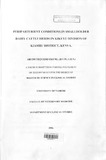| dc.description.abstract | The conditions affecting dairy cattle during the periparturient period have been
documented in various parts of the world. Most of these reports are based on large-scale
dairy herds reared under intensive production systems. However, there is limited
information on the occurrence of these conditions in the smallholder dairy production
system. This study was therefore conducted to determine the periparturient conditions
affecting smallholder dairy cattle in Kikuyu Division of Kiambu District. The objectives
of the study were:
1) To determine the incidence of diseases affecting dairy cattle during the periparturient
period in Kikuyu Division; 2) To determine their pattern of occurrence across seasons
and agro-ecological zones; 3) To determine the herd level risk factors of the
periparturient conditions.
Smallholder farms having .10dairy cattle were selected into the study. The selection was
progressive and purposive based on the presence of at least one animal 3-8 months
pregnant in the herd and the farmers' willingness to participate in the study. The willing
farmers were recruited. A total of 117 farms were selected for the study. Two hundred
and six animals were recruited of which 150 were from the lower highland agroecological
zone (Altitude 1820 - 2070 m above sea level) and 56 from the upper midland
agro-ecological zone (Altitude 1200-1820m above sea level). One hundred and thirteen
animals were followed up during the dry season while 93 were followed-up during the
wet season.
Monthly visits were carried out for pregnant animals that had not entered the
periparturient period (> 3 weeks prior to parturition) and weekly visits carried out as soon
as the animals entered the periparturient period (3 weeks before and 3 weeks after
parturition). Data was collected during farm visits by observation, semi-structured
interviews and clinical examination of animals.
Descriptive statistics were determined for breed, sex of offspring, agro-ecological zone,
season and management practices. Disease incidences were also calculated.
The Chi square (l) test was used to determine unconditional associations between
periparturient conditions and potential predictor variables at the 5 % level of significance.
Multiple logistic regression procedure was carried out to model the effects of potential
risk factors on the occurrence of periparturient conditions. Factors that were found
significant (P <0.05) were retained in the model. The odds ratio (O.R.) as a measure of
the strength of association between significant variables was calculated as the reciprocal
of the antilogit of the estimate for that variable. Interaction and confounding between the
variables were controlled analytically in the regression modelling.
The overall incidence of the periparturient conditions was 0.67. The incidences of the
most common conditions encountered were retained placenta 0.281, dystocia 0.135, milk
fever 0.111, downer cow syndrome 0.097, mastitis 0.087 and metritis 0.063.
Factors significantly associated with the development of retained afterbirth were milk
fever (O.R. = 5.2, P = 0.041) and history of having developed retained afterbirth in a
previous parturition (O.R. = 2.3, P = 0.045). Factors significantly associated with the
development of downer cow syndrome were milk fever (O.R. = 9.32, P = 0.001) and lack
of supplemental feeding (O.R. = 4.8, P = 0.007). The wet season was significantly
associated with the development of mastitis (O.R. = 4.1, P = 0.015). Factors significantly
associated with the development of metritis were dystocia (O.R. = 3.96, P = 0.021) and
retained afterbirth (O.R = 5.24, P = 0.026). Dystocia was significantly associated with
the development of peri parturient haemorrhage (O.R = 10.55, P = 0.012) and injuries to
the birth canal (O.R = 58.96, P <0.01).
From this study it can be concluded that retained placenta, dystocia, milk fever, downer
cow syndrome, mastitis and metritis are common periparturient conditions in smallholder
dairy cattle herds in Kikuyu Division of Kiambu District. Most of the conditions were
interrelated with one condition predisposing the occurrence of the other.
It is recommended that more research be carried out to determine the impact of these
diseases on the productivity and performance of cattle in the smallholder dairy production
system and the dairy sector as a whole in this country. | en |

